Extended Data Fig. 2. Intestinal transit dynamics and dietary regulation of crop enlargement.
a, Cartoon summarising ad libitum and starvation/re-feeding assays using dye-laced food. b-c’, Transit of dye-laced food, intestinal transit at specific time points after ingestion. b, Gut dissected 10 seconds after feeding initiation; food is apparent in the crop duct and begins to enter the crop. b’, Gut dissected 40 seconds after feeding initiation; food fills the crop duct, crop, and begins to enter the midgut. b″, Gut dissected 2 minutes after feeding initiation; food fills the crop, crop duct and midgut. b″, Gut dissected 40 minutes after feeding initiation; food fills the crop, crop duct, midgut and has now reached the hindgut and rectal ampulla. All panels show dissected adult fly intestines, anterior (left) posterior (right). c,c’, Frequency histogram derived from in vivo food ingestion videos (see Supplementary Video 1 for a representative example) showing higher number of flies with faster transit times of food to the crop (c) compared to midgut (c’). d, Quantification of crop area revealed that re-feeding after starvation results in larger crops than ad libitum feeding. e-e″, Representative dissected guts of a starved fly (e, 16h starvation on 1% agar), starved-refed fly (e’, 16h starvation on 1% agar, refed for 20min on dye-laced standard food), ad libitum-fed fly (e″, fed on dye-laced standard food for 2h). f, Ability of different food sources to elicit crop enlargement. These are categorized as palatable (P) and/or nutritious (N) using filled boxes if true and empty boxes if false (see Methods for further details of the different diets). In this and all subsequent ranked data panels, crop size was ranked as one of four categories: small (S), medium (M), large (L) and very large (VL). Graphs are colour-coded from light to dark shades of red corresponding to increasing size of the crop. Data are displayed as percentages. Scale bars = 500μm. See Supplementary Information for a list of full genotypes, sample sizes and conditions. In all boxplots, line: median; box: 75th-25th percentiles; whiskers: minimum and maximum. All data points are shown. *: 0.05>p>0.01; **: 0.01>p>0.001; ***: p<0.001.

